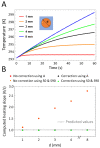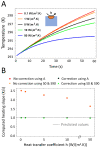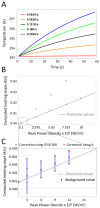Investigating a Lock-In Thermal Imaging Setup for the Detection and Characterization of Magnetic Nanoparticles
- PMID: 32854404
- PMCID: PMC7559474
- DOI: 10.3390/nano10091665
Investigating a Lock-In Thermal Imaging Setup for the Detection and Characterization of Magnetic Nanoparticles
Abstract
Magnetic hyperthermia treatments utilize the heat generated by magnetic nanoparticles stimulated by an alternating magnetic field. Therefore, analytical methods are required to precisely characterize the dissipated thermal energy and to evaluate potential amplifying or diminishing factors in order to ensure optimal treatment conditions. Here, we present a lock-in thermal imaging setup specifically designed to thermally measure magnetic nanoparticles and we investigate theoretically how the various experimental parameters may influence the measurement. We compare two detection methods and highlight how an affordable microbolometer can achieve identical sensitivity with respect to a thermal camera-based system by adapting the measurement time. Furthermore, a numerical model is used to demonstrate the optimal stimulation frequency, the degree of nanomaterial heating power, preferential sample holder dimensions and the extent of heat losses to the environment. Using this model, we also revisit some technical assumptions and experimental results that previous studies have stated and suggest an optimal experimental configuration.
Keywords: lock-in thermal imaging; magnetic nanoparticles; measurement instrument; thermal imaging.
Conflict of interest statement
Both Christoph Geers and Mathias Bonmarin have equities in the company Nanolockin GmbH that is commercializing lock-in thermal imaging instruments for NP detection and that might benefit from the research performed in this study.
Figures









Similar articles
-
Real-time infrared thermography detection of magnetic nanoparticle hyperthermia in a murine model under a non-uniform field configuration.Int J Hyperthermia. 2013 Dec;29(8):752-67. doi: 10.3109/02656736.2013.839056. Epub 2013 Oct 18. Int J Hyperthermia. 2013. PMID: 24138472
-
Magnetic nanoparticle heating and heat transfer on a microscale: Basic principles, realities and physical limitations of hyperthermia for tumour therapy.Int J Hyperthermia. 2013 Dec;29(8):790-800. doi: 10.3109/02656736.2013.822993. Epub 2013 Aug 22. Int J Hyperthermia. 2013. PMID: 23968194 Review.
-
Effect of heat dissipation of superparamagnetic nanoparticles in alternating magnetic field on three human cancer cell lines in magnetic fluid hyperthermia.Electromagn Biol Med. 2016;35(4):305-20. doi: 10.3109/15368378.2015.1089409. Epub 2016 Mar 25. Electromagn Biol Med. 2016. PMID: 27015154
-
Physics of heat generation using magnetic nanoparticles for hyperthermia.Int J Hyperthermia. 2013 Dec;29(8):715-29. doi: 10.3109/02656736.2013.836758. Epub 2013 Oct 16. Int J Hyperthermia. 2013. PMID: 24131317 Review.
-
Calorimetric method of ac loss measurement in a rotating magnetic field.Rev Sci Instrum. 2010 Jul;81(7):074702. doi: 10.1063/1.3458003. Rev Sci Instrum. 2010. PMID: 20687748
Cited by
-
Electrospun Magnetic Nanofiber Mats for Magnetic Hyperthermia in Cancer Treatment Applications-Technology, Mechanism, and Materials.Polymers (Basel). 2023 Apr 15;15(8):1902. doi: 10.3390/polym15081902. Polymers (Basel). 2023. PMID: 37112049 Free PMC article. Review.
-
Quantification of nanoparticles' concentration inside polymer films using lock-in thermography.Nanoscale Adv. 2023 Apr 27;5(11):2963-2972. doi: 10.1039/d3na00091e. eCollection 2023 May 30. Nanoscale Adv. 2023. PMID: 37260492 Free PMC article.
References
-
- Rosensweig R.E. Heating magnetic fluid with alternating magnetic field. J. Magn. Magn. Mater. 2002;252:370–374. doi: 10.1016/S0304-8853(02)00706-0. - DOI
Grants and funding
LinkOut - more resources
Full Text Sources

